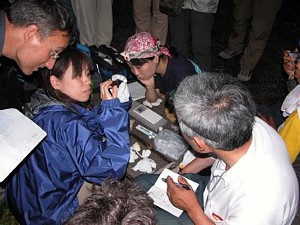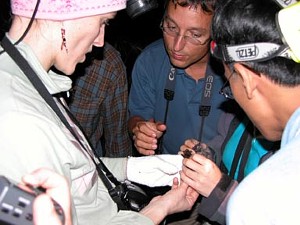|
 9 Международный Конгресс по Млекопитающим
9 Международный Конгресс по Млекопитающим
Конгресс
проходил с 31 июля по 5 Августа 2005 в Саппоро, Япония. По
данным оргкомитета, на нем присутствовало более тысячи участников
из 52 стран.
Конгресс представлял из себя серию симпозиумов, параллельно
с которыми шли пленарные доклады, которые по тем или иным
причинам не попали ни в один из симпозиумов, а в одном из
залов были представлены постеры. К сожалению, большое количество
докладов негативно сказалось на организации расписания и некоторые
сессии по близким тематикам или по более-менее общим вопросам
были поставлены в одно и тоже время. В связи с этим участникам
приходилось в какой-то момент делать порой нелегкий выбор
в пользу одного из докладов, а в другое время занимать себя
самостоятельно в перерывах между докладами. Тем не менее,
несмотря на некоторую несогласованность в расписании, все
доклады, касающиеся летучих мышей, не пересекались во времени.
Основной симпозиум, посвященный исключительно рукокрылым,
прошел 4 августа под названием "Экология и охрана рукокрылых
стран Азиатско-Тихоокеанского региона" (S39: Ecology and conservation
of bats in the Pacific Rim). На симпозиуме были представлены
13 докладов (см. ниже) некоторые из которых хотелось бы выделить
особо. Кайл Армстронг (Kyle Armstrong, Kyoto University Museum)
в докладе о филогеографии японских подковоносов показал, что
по результатам анализа митохондриальной ДНК, биологии и эхолокации,
взаимоотношения внутри группы не соответствуют принятым представлениям,
а следовательно некоторые виды должны быть сведены в синонимы.
В то же время, на одном из островов Японского архипелага популяция
японского подковоноса генетически разнородна на уровне видов.
 Бурное
обсуждение последовало за докладом Стюарта Парсонса (Stuart
Parsons, The University of Auckland) об опыте охраны рукокрылых
в Новой Зеландии путем их переселения на другие острова. В
результате эксперимента, продолжающегося уже нескольких лет,
был разработан протокол, позволяющий минимизировать возвраты
и ускорить адаптацию рукокрылых на островах, свободных от
хищников. Бурное
обсуждение последовало за докладом Стюарта Парсонса (Stuart
Parsons, The University of Auckland) об опыте охраны рукокрылых
в Новой Зеландии путем их переселения на другие острова. В
результате эксперимента, продолжающегося уже нескольких лет,
был разработан протокол, позволяющий минимизировать возвраты
и ускорить адаптацию рукокрылых на островах, свободных от
хищников.
Помимо данного симпозиума, доклады о рукокрылых были представлены
еще на трех симпозиумах (S07, S12 и S42), пленарных и постерных
сессиях, а так же на семинаре по национальному парку Ноппоро
(W24: Nopporo Forest Park and Mammalogy).
 После
конгресса Дай Фукуи и Кунико Каваи (Hokkaido University) организовали
поездку на экспериментальную станцию Университета Хоккайдо
в Томакомае для ознакомления с рукокрылыми Хоккайдо. После
конгресса Дай Фукуи и Кунико Каваи (Hokkaido University) организовали
поездку на экспериментальную станцию Университета Хоккайдо
в Томакомае для ознакомления с рукокрылыми Хоккайдо.
Официальную информацию о конгрессе можно найти здесь: http://www.imc9.jp/
Следующий Международный териологический конгресс состоится
в Сантьяго де Чили в 2009 году.
Доклады о рукокрылых, представленные на Конгрессе:
S07: The pattern of diversification of the East Asian mammal
fauna
S0704. Liang-Kong Lin and C. W. Chu: Genetic variation and
population structure of two Hipposiderid bats in Taiwan.
S0707. Manuel Ruedi and Benoit Stadelmann: Biogeographic evolution
of the genus Myotis (Chiroptera: Vespertilionidae)
inferred from mitochondrial and nuclear DNA.
S12: Life histories: The basics revisited.
S1209. Matina Kalcounis-Ruppell: Linking energy expenditure
and life history characteristics of mammals: A comparative
phylogenetic analysis of North American murid rodents and
vespertilionid bats.
S39:
Ecology and conservation of bats in the Pacific Rim
CONVENERS: David A. Hill, Kimitake Funakoshi, and Sumiko Matsumura
The Pacific Rim of Asia has a great diversity of bats, in
terms of both species richness and the ecological niches they
occupy. As new species are still being identified, and the
probability of cryptic species being found in the region is
high, it seems likely that our knowledge of bat systematics
is also incomplete. Conservation of bats in the region is
also a major problem. They face a great variety of threats,
the most pervasive of which is the loss and degradation of
habitats. A basic understanding of habitat requirements is
a prerequisite for assessing the nature and scale of threat,
and for taking action to remove it. However, only a small
minority of species in this region has been studied, and knowledge
of their ecology is therefore limited. This symposium will
bring together examples of studies relevant to the ecology
and conservation of bats in the region. It will consider how
various approaches and techniques have contributed to current
knowledge in this and other regions, and will aim to identify
priorities for future work that will promote conservation
of bats in the Pacific Rim of Asia.
 S3901.
Katerina Tsytsulina: The problem of sibling species in current
Chiroptera systematics: Genetic and morphological attempts. S3901.
Katerina Tsytsulina: The problem of sibling species in current
Chiroptera systematics: Genetic and morphological attempts.
S3902. Kyle Armstrong, M. Harada, L.-K. Lin, and Y. Wu: Phylogeography
of the Rhinolophus cornutus (Chiroptera: Rhinolophidae)
lineage in mainland Japan and the Ryukyu Archipelago.
S3903. Kuniko Kawai: Molecular phylogeography of Japanese
and East Asian bats.
S3904. Lazaro Echenique-Diaz: Ecology and conservation genetics
of Hipposideros turpis turpis on the Yaeyama Islands.
S3905. Paul Bates: Building a taxonomic network for Asian
bat studies.
S3906. Sumiko Matsumura: Postnatal growth and timing of parturition
of Hipposideros turpis in some colonies on Iriomote
Island.
S3907. Liang-Kong Lin and H. C. Chiang: Selection of day roosts
by Myotis formosus flavus in rural areas in Central
Taiwan.
S3908. Dai Fukui, N. Agetsuma, M. Murakami, D. A. Hill, S.
Nakano, and T. Aoi: Factors that influence foraging habitat
use of insectivorous bats in temperate forest in Hokkaido,
Japan.
S3909. David A. Hill: Comparative survey of bats in conifer
plantations and natural broadleaved forests in Yakushima,
Japan.
S3910. S. Juliana, T. Kingston, A. Norhayati, and A. Zubaid:
Landscape level variability of insectivorous bat assemblages
at Krau Wildlife Reserve, Malaysia.
S3911. Tigga Kingston and A. Zubaid: Bat conservation and
the Malaysian Bat Conservation Research Unit.
S3912. Stuart Parsons, J. Guilbert, J. Ruffell, and M. Walker:
Conservation through translocation: Moving endangered bats
to predator-free offshore islands.
S3913. Kimitake Funakoshi, T. Kunisaki, N. Sugita, K. Tsuchiya,
and E. Hosoi: Ecology and conservation of the northern Ryukyu
fruit bat, Pteropus dasymallus.
S42: Macroecology of mammal-parasite relationships
S4203. P. Christe and R. Arlettaz: Environmental conditions,
parasitism and immune defense in bats.
Пленарные доклады:
O317301. V. Matveev: Inter-SINE-PCR genetic distances as markers
of taxonomic levels in mammals, by the example of bats.
O317302. C. L. Hice, P. M. Velazco, C. M. Brown, and J. H.
Brown: Going beyond presence/absence data: Neotropical bat
communities as a case study.
O317303. S. Campbell, L. Lumsden, and G. Coulson: So long
as it's near water; flexible roostingbehavior of the large-footed
myotis in Australia.
Постеры:
P10704. C.-H. Chou and L.-K. Lin: Taxonomic status of Myotis
(Chiroptera: Vespertilionidae ) in Taiwan.
P27301. H. Murai: Notice of cluster of hibernating Japanese
horse-shoe nosed bats, Rhinolophus ferrumequinum in
Toyama Prefecture.
P27302. M. Yamasaki, Y. Sakamoto, and S. Matsumura: Development
of sounds in the greater tube-nosed bat, Murina leucogaster.
P27303. A. Nakamoto, K. Sakugawa, K. Kinjo, and M. Izawa:
The role of the Ryukyu flying-fox as a seed dispersal agent
on Okinawa-jima Island, Japan.
P27304. K. Maeda, H. Hashimoto, and M. Matsumoto: Hanging
position in the colony of Bang's leaf-nosed bats, Hipposideros
turpis of Otomi-Daiichi cave, Iriomote Island, Okinawa
Prefecture, Japan.
P27305. K. Kinjo, K. Higashi, A. Nakamoto, and M. Izawa: Current
status of the endangered Daito flying-fox, Pteropus dasymallus
daitoensis (Chiroptera: Pteropodidae).
P27306. S. Yasui, T. Kamijo, A. Mikasa, and M. Shigeta: The
distribution and roosts of Myotis ikonnikovi in Tochigi
Prefecture, Central Japan.
P27307. D. Fukuda, T. Kamijo, and S. Yasui: Day roosts of
Myotis ikonnikovi during the breeding season in Nikko,
Central Japan.
P27308. A. Tsuji, K. Koyanagi, H. Tamura, H. Nagaoka, and
K. Maeda: Distribution and seasonal change of population size
for cave dwelling bats in Ishigaki Island (2001-2004).
P27309. M. Brazil and N. Sasaki: The bat fauna of Nopporo
forest park.
P27310. I. Maryanto and S. Higashi: Comparison of zoogeography
among Indonesian rats, fruit bats and insectivorous bats in
Indonesia.
P27311. S.V. Gazaryan, and V.A. Matveev: The taxonomy and
distribution of Barbastella species in the Caucasus
P27312. M. Sharifi, H. Ferrasat, and V. Akmali: Sexual dimorphism
in the greater mouse-tailed bat, Rhinopoma microphyllum
in Northern Mesopotamian plain.
P27313. M. Sharifi: Postnatal growth in the long fingered
bat, Miniopterus schreibersii.
P27314. F. Spoutil and I. Horacek: Geographic variability
in European horseshoe bats (Rhinolophidae).
P27315. I. Horacek and F. Spoutil: Maturation of enamel in
Myotis myotis (Chiroptera, Vespertilionidae).
P27316. H. Tamura, M. Izawa, and K. Maeda: Movement pattern
of the Ryukyu bent-wing bat on Okinawa island.
P43901. N. Sugita, M. Inaba, and K. Ueda: Do Bonin flying-fox
males exploit female clusters preventing temperature loss
for mate guarding?
P43902. H.C. Chang and L. K. Lin: A maternity colony of Myotis
formosus flavus in a traditional house of Taiwan.
P43903. H.-C. Cheng and L.-W. Changchien: Current status and
distribution of bats in Taiwan.
P43904. A. Sano: Structure of the maternity population and
reproductive traits in the Japanese greater horseshoe bat.
P43905. N. Kondo, N. Sasaki, H. Hirakawa, and K. Kawai: Ecology
of eastern barbastelle bats, Barbastella leucomelas,
(Chiroptera) in Eastern Hokkaido, Japan.
P43906. M. Struebig, A. Suyanto, and E. Meijaard: Bats of
Borneo: Species diversity and distributions following recent
surveys of Kalimantan.
P43907. S. Campbell: Australia's fishing-bat; diet composition
of the large-footed myotis, Myotis macropus.
P43908. V. D. Thong: Status of bats in Vietnam.
P43909. S. Bumrungsri: The role of nectarivorous bat, Eonycteris
spelaea, in the pollination of food plants.
Абстракты можно попросить у Катерины Цыцулиной
tsytsulina@hotmail.com
© Фото: Kyle Armstrong, Nicte Ordonez.
E. A. Цыцулина
22.09.05
|



